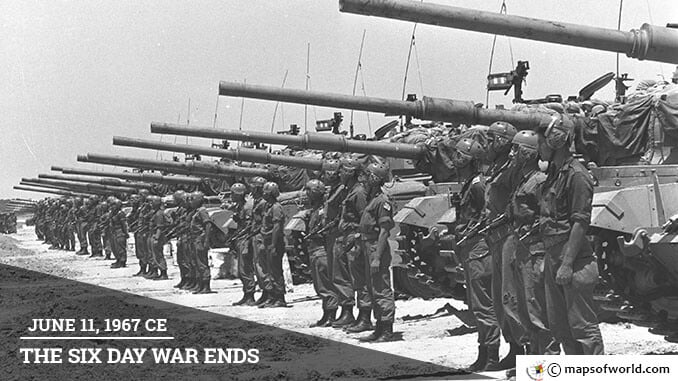For the first time in a week, the sun rose in peaceful skies around the Sinai Peninsula on June 11th,1967. The nation of Israel, surrounded by hostile armies from Egypt, Syria and Jordan, scored an impressive victory – tripling its land holdings in the region in very short order. Much of the territory that fills peace talks and news broadcasts today was claimed by the tiny Jewish state during this battle: the Gaza Strip, West Bank, East Jerusalem and Golan Heights remain within the contested Israeli borders still. Since 1949, tensions in the region had boiled over periodically – the 1956 Suez Crisis, in particular, gave officials on both sides reason to expect the worst. The Arabs and Israelis continued to skirmish from time to time, with the Syrians proving to be the most familiar foes to their counterparts in Israel over the next eleven years. Then, in November 1966, the announcement of a mutual defense agreement between Egypt and Syria seemed to make another battle unavoidable. Emboldened by the knowledge an alliance existed, members of the Palestine Liberation Organization (PLO) began to increase attacks in in Israeli-held territory. Angered by the perceived compliance on the part of neighboring Arab governments, the Israeli Defense Force swept into as-Samu in the West Bank, driving the Jordanian forces out. The United Nations (UN) Security Council protested such unilateral action, but the call fell on deaf ears. Action by the PLO continued at a heightened pace in the aftermath, such that Israeli officials – angry at Syria’s willingness to allow Palestinians to pass into Israel unchecked – threatened military action the following May. The response was ominous: the Egyptian army pushed more than 100,000 troops into the Sinai Peninsula, expelling a UN peacekeeping force in the process. Four days later, the Egyptians closed the Straits of Tiran, cutting off Israeli shipping. War was now inevitable. Jordan and Egypt signed an alliance on May 30th. The next day, Iraqi soldiers and tanks rumbled into Jordan. Feeling the options were solely to attack or be attacked, the National Unity Government of Israel – an expansion of its traditional cabinet – voted to approve Operation Focus on June 4th. The following morning, Israel seized the initiative with a massive airstrike on Egyptian airfields. Some 94% of the operational Israeli Air Force slipped out over the Mediterranean and Red Seas, then sped in low over the coast to avoid radar detection. The attack was a major success, destroying large numbers of Egyptian bombers and neutralizing radar installations. Israel essentially controlled the skies from the get-go. At the same time, Israeli infantry moved into Sinai to take advantage of the confusion caused by their fighters. Within two days, much of the peninsula was under the Israeli flag – the army had reached the Suez Canal – but the battle would rage on elsewhere: the Jordanians had moved in on Jerusalem and the Syrians had begun shelling northern Israel. By June 7th, the same day the Israeli rout of the Egyptian army was completed, forces from Jordan had been pushed out of the West Bank. Over the next three days, despite a heated internal debate amongst the Israeli cabinet, Syrian forces on the Golan Heights would soon fall victim to the ruthless efficiency of Israel’s armed forces – a swift retreat on the morning of June 10th left the Arab world reeling, as four of its most advanced military powers had been soundly defeated by just one. With the political fallout and shifting borders, much changed for the combative nations. Israel had gained significant strategically-favorable territory – much of which would come in handy during the Yom Kippur War in 1973 – and an air of legitimacy as a military force capable of doing more than just defending itself. For the roughly one million Arabs in the occupied territories, life became complicated immediately: almost a third fled to Jordan (contributing to a growing social unrest), while the remainder stayed under the authority of the Israeli government – an unsavory fact that boosted the membership rolls of the PLO and continues to result in death and destruction almost five decades later.
June 11, 1967 CE – The Six Day War Ends
For the first time in a week, the sun rose in peaceful skies around the Sinai Peninsula on June 11th,1967. The nation of Israel, surrounded by hostile armies from Egypt,…
